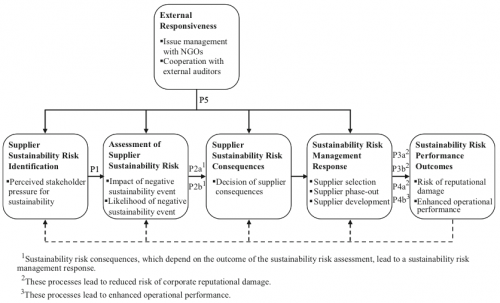Managing Supplier Sustainability Risks
For many years sustainability risks have been largely neglected. Reputational damages caused by incidents like the Brent Spar platform can reach tens of millions of dollars. But in a supply chain context companies are not only held responsible for their own actions but also for the actions of their suppliers.
In their 2010 paper Foerstl et al. analyze supplier sustainability risk and develop and test a framework for its mitigation.
Research question
Scholars agree that sustainable supplier management (SSM) cannot only rely on a supplier’s compliance declaration. Nonetheless, there has also been consensus, that risk mitigation measures are costly and therefore have to be targeted towards the most risky suppliers. The authors address the following research questions:
- How do firms configure sustainable supplier risk management processes in congruence with dynamically changing sustainability requirements?
- How can supplier sustainability risk mitigation strategies and processes be a source of competitive advantage to the buying firm?
Research framework and methodology
The authors use the research framework in figure 1 as foundation for their further research. The framework describes the process within a company from the “supplier sustainability risk identification” to the related “performance outcomes”.
Since the research on how firms account for sustainability-related risks are still in an exploratory / early stage the authors decided to use a case study design to build new hypothesis is this field.
The case study participants (5 overall) have been selected to be from the chemical industry, since
first, environmental protection has high strategic relevance in the chemical industry since its costs are among the highest of all industries. Second, the industry’s high profitability and a long history of incidents have led to close scrutiny by its stakeholders, emphasizing the relevance of responsible environmental and social behaviour.
Data analysis
The findings fit into the above mentioned framework and are denoted in figure 2 by P1 to P5.
- Proposition 1
The initial development of sustainability risk assessment is based on the perceived stakeholder pressure, but the chosen risk assessment method is independent of the pursued sustainability dimension.
- Proposition 2a
Supplier sustainability risk assessment enables an effective sustainability risk mitigation response.
- Proposition 2b
The initial configuration and deployment of supplier sustainability risk management capabilities is valuable in building excess capacity, which enables firms to broaden the scope of their sustainability risk management processes.
- Proposition 3a
The ability of sustainable supplier selection, development and phase-out strategies to mitigate sustainability risks depends on the rigor with which they are applied.
- Proposition 3b
The ability of sustainable supplier assessment and development capabilities to mitigate sustainability risks depends on the astuteness with which they are created and applied.
- Proposition 4a
Sustainability risk assessment capabilities allow for effective supplier selection, leading to risk reduction, which constitutes a source of competitive advantage.
- Proposition 4b
Beyond the reduction of supplier sustainability risks, sustainable supplier development has a positive effect on operational performance and hence competitive advantage.
Additionally, the author discovered the issue of “external responsiveness”, which has not been part of the original model. It relates to the response time towards new social and environment standards. Two of the interviewed companies also directly approached Non Governmental Organizations (NGOs) to integrate these groups into their sustainability risk management processes.
- Proposition 5
Under the presence of dynamic stakeholder stimulus, external responsiveness has a positive effect on sustainability risk identification, assessment and mitigation processes, which in turn affect sustainability risk performance outcomes.
Results
As a summary the authors conclude that
- the earlier firms begin to assess their suppliers for sustainability, the greater the accumulation of sustainability-related risk management capabilities relative to their competitors will be.
- sustainable supplier assessment and development has positive effects on the buying firm: 1) more profound mitigation of corporate reputational risk and 2) enhanced operational performance.
- supplier assessment, selection, and development must be tightly interlocked to effectively manage the sustainability risk exposure caused by individual suppliers or the supply base as a whole
Conclusion
The authors did a great job presenting their results. I was positively surprised to see that they elaborated on three pages about the application of the case study methodology and the sample companies. The sample selection towards companies with great emphasis on sustainability overall (e.g. the companies have all been picked from major sustainability related stock indices) of course leads to a skewed sample which cannot be seen as a representative average, but more as a best practice example.
Foerstl, K., Reuter, C., Hartmann, E., & Blome, C. (2010). Managing supplier sustainability risks in a dynamically changing environment—Sustainable supplier management in the chemical industry Journal of Purchasing and Supply Management, 16 (2), 118-130 DOI: 10.1016/j.pursup.2010.03.011









Add new comment